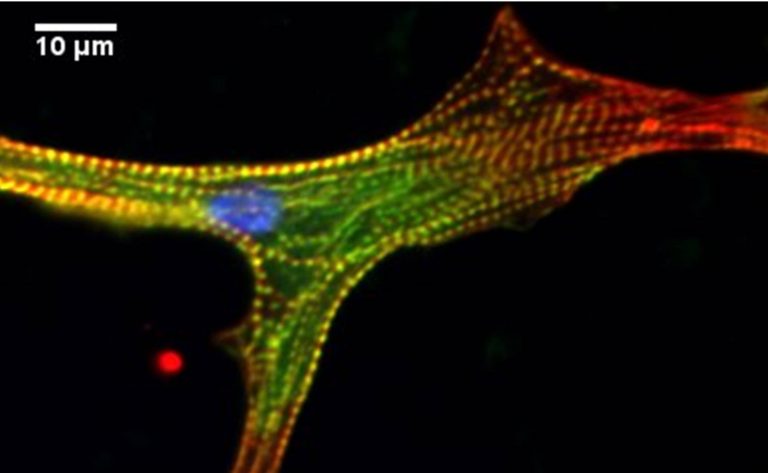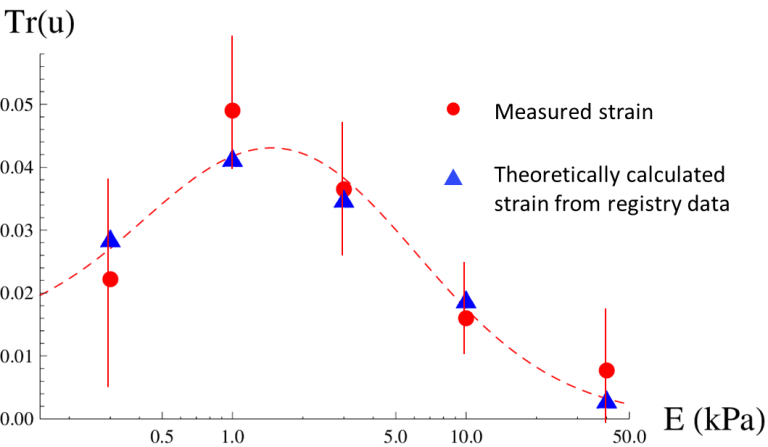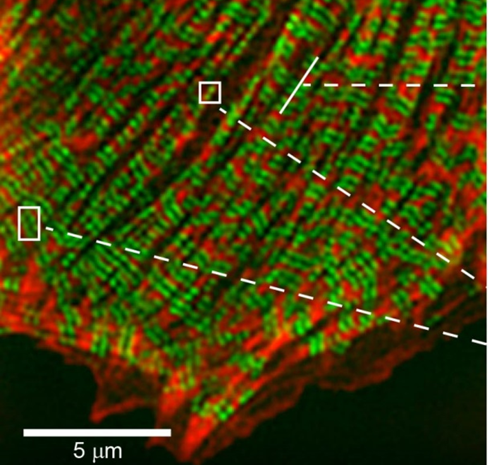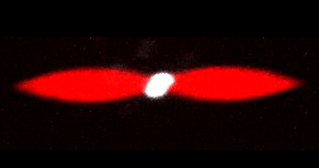For a more updated list of research interests and publications, please visit my google scholar profile
Biological Physics:
Cell Mechanics/Mechanobiology. Current research is revealing that mechanical forces are important to biology in a variety of ways: think of muscles contracting, or tissues being deformed, folded and shaped during embryo development. I want to delve deeper into the organizational role of mechanics in biology, particularly how forces act in concert with the chemical and genetic factors ubiquitous in biology.
- Structural order and phase coherence in heart muscle cells

Recent experiments at the Discher laboratory at the University of Pennsylvania show that both striation, an indication of the structural registry of muscle fibers, as well as the contractile strains produced by beating cardiac muscle cells can be optimized by substrate stiffness. We calculated the elasticity-mediated structural registry as a phase order parameter using a statistical physics approach that takes the noise inherent in biological systems into account and showed theoretically how the substrate rigidity dependence of the registry data can be mapped onto the strain measurements. The remarkable agreement of our ideas with experiment suggests that the correlated beating of heart cells is related to the structural registry of the myofibrils which in turn is regulated by their elastic environment. Our central assumption here is that myofibrils that are structurally more registered would also tend to beat in phase. I am interested in further exploring this hypothesis and its implications through collaboration with controlled experiments on cardiomyocytes on micropatterned substrates. This research has potential implications for understanding cardiac disease especially fibrillation and has received some attention on science news pages. Article: Nature Communication 2015

Beating Strain vs. substrate elasticity: theoretical predictions from structural order parameter (registry) measurements (by imaging a cardiac myocyte) match strain measurements (by imaging deformations of the underlying gel substrate as the cardiac myocyte beats)
2. Ordered organization of the cytoskeleton in non-muscle cells

Myosin motors bind to actin filaments to generate forces within the cell that are needed to perform various functions such as locomotion. New super-resolution images from our collaborators, the Bershadsky lab at Singapore and Weizmann, show that the myosin motor filaments (labeled in green) are spatially organized into stacks reminiscent of structural order in muscle cells. Read about this exciting research in this recently published article in Nature Cell Biology, and an accompanying commentary. The stacking depends sensitively on myosin-generated contractile forces, on actin polymerization and turnover, and on the presence of cross-linkers. We are extending our theory for spatial registry of myosin via elastic interactions to model these dynamics. Watch this space for more exciting developments in this area! Beautiful super-resolution microscopy images and movies of actomyosin in the cell are found in this Bershadsky lab page.
3. Mechanochemical proposal for proportionate patterning of cell assemblies (scaling)
A remarkable aspect of developing groups of cells in the early embryo is the controlled and orchestrated way in which the various pattern-forming processes, which lead to a complex, differentiated, multi-cellular organism from a single cell, are executed. Motivated by the notion of well-controlled gradients of signaling molecules called morphogens that help define the basic body plan of the multicellular embryo (read Alan Turing’s original proposal here), we posit the idea of “mechanogens”: diffusible biomolecules that affect cell contractility. In particular, cells can elastically interact with each other through the deformation of the surrounding extra-cellular matrix, or by directly pulling on each other through their adhesion junctions, by cytoskeletal forces generated by acto-myosin contractility. Such elastic interactions are long-ranged, travel much faster than chemical diffusion, and could facilitate global effects in the pattern forming process. We have shown theoretically that an interplay of chemical diffusion and elastic interactions between force dipoles can lead to long-range mechanochemical gradients that scale with tissue size . This may explain the observed tendency for “scaling” in development, where embryos maintain their proportions over variations in their size within a good degree of accuracy.
Biological Active Matter:
Active matter i.e. collections of self-driven particles that involve energy injection at the particle scale are a rich and rapidly developing topic in physics. They show diverse phenomena such as dynamic phase separation, anomalous transport, giant number fluctuations and even topological edge modes, not seen in matter at thermodynamic equilibrium. Biological materials such as cytoskeletal filaments driven by molecular motors provide an important class of such active systems. Modeling these active materials or theoretically predicting their behavior can teach us both about biology and create new problems in nonequilibrium statistical physics!
Liquid crystal droplets of biomaterial that mimic cell division

Although actin is organized intro cross-linked elastic networks (Gels) in the cellular cytoskeleton, in vitro experiments with purified actin extracted from the cell show a fluid phase. To achieve this, Dr. Kimberley Weirich in the Gardel laboratory at the University of Chicago, capped the polymerization of actin to submicron lengths. We use models familiar in liquid crystal physics to describe why these short actin rods form spindle-shaped droplets (tactoids) shown in the accompanying figure and then phenomenologically describe their observed liquid drop-like behavior. They grow, merge and exhibit capillary instabilities. More recently, we find even more striking behavior when motors are added to the actin tactoids: the motors localize to the center of the tactoid and pinch it apart into two daughter droplets! This is a novel realization of active matter where a few active constituents are able to self-organize and deform a passive fluid droplet.
Topological edge modes in dissipative active fluids
Can topologically protected states occur in classical fluids? What about matter that is driven out of thermodynamic equilibrium? We show by mapping to a simple model for a Chern insulator familiar from quantum condensed matter that a hydrodynamic theory may also have spectrum characterized by a topological index. Unlike electrons which are waves, our fluid supports modes that are diffusive and decay over a relaxation time Like topological insulators which conduct current on the edge but not in the bulk, fluctuations of flow decay quickly in the bulk but can be very long-lived on the edge. This bulk-edge difference is related to friction from an underlying substrate. Below is a plot showing how quickly fluctuations in vorticity, a measure of the circulating flow of objects driven on top of a frictional substrate (could be colloids spun by a rotating magnetic field), die as a function of their wavenumber because of momentum/energy being sucked out by friction. The fluctuations are longer lived on the edge and are separated by a “gap” from the bulk dispersion curve. The inset shows how the flow is localized at the edge despite the presence of obstacles.
Miscellaneous soft matter and complex fluids
Molecular layering and colloidal stability in ionic fluids
The Talapin lab at the University of Chicago has shown for the first time that colloidal nanocrystals can be stably suspended in molten inorganic salts. They can engineer the surface chemistry to stabilize various colloids although the usual mechanisms for colloidal stabilization such as polymer brush coating or double layer repulsion are not accessible in this system. We show with molecular simulations and a phenomenological model that accounts for both steric and Coulombic interactions, that the long-range layering templated by a colloidal surface in the ionic fluid (here, molten salt) can act to stabilize these particles. We are working to extend this model to describe the long-ranged correlations in a dense ionic fluid. The question of ionic correlations and screening are also important in biology: life requires salt water.
Article : Nature, 2017, Popular article:

